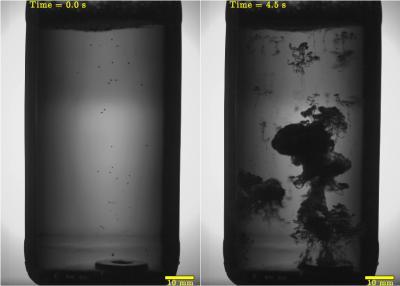If you have ever wondered about why you can tap a newly opened beer bottle and its suds will foam out and go all over the place, researchers from Carlos III University and Universite Pierre et Marie Curie, Institut Jean le Rond d'Alembert have provided some insight - by exploring the phenomenon of cavitation.
Cavitation, a phenomenon relevant to such common engineering concerns as erosion of ship propellers, is the mechanism by which bubbles appear in a liquid such as beer after an impact, said Javier Rodriguez-Rodriguez, the lead researcher from Carlos III University.
After a sudden impact against a bottle's mouth, back and forth movement of compression and expansion waves will cause bubbles to appear and quickly collapse. The team's investigation of beer bottle-fluid interactions demonstrated that the cavitation-induced break-up of larger "mother" bubbles creates clouds of very small carbonic gas "daughter bubbles," which grow and expand much faster than the larger mother-bubbles from which they split. The rapid expansion of these daughter bubbles gives the foam buoyancy.

A chain of physical phenomena occurring after your bottle is hit leads to a well-known consequence: your beer quickly turns into foam. Credit: Javier Rodriguez-Rodriguez / Carlos III University of Madrid, SPAINAlmudena Casado-Chacon / Carlos III University of Madrid, SPAINDaniel Fuster / CNRS (UMR 7190), Université Pierre et Marie Curie, Institut Jean le Rond d'Alembert, FRANCE
"Buoyancy leads to the formation of plumes full of bubbles, whose shape resembles very much the mushrooms seen after powerful explosions," Rodriguez-Rodriguez explained. "And here is what really makes the formation of foam so explosive: the larger the bubbles get, the faster they rise, and the other way around." He adds that this is because fast-moving bubbles entrain more carbonic gas.
The team's work is believed to be the first quantitative analysis of the beer bottle foamover. "We wanted to explain the extremely high efficiency of the degasification process that occurs in a beer bottle within the first few seconds after the impact," Rodriguez said.
Beyond happy-hour enrichment, the study's findings can be applied to other engineering systems and serious natural phenomena such as the sudden release of dissolved carbon dioxide in the Lake Nyos disaster.
Presentation"Why does a beer bottle foam up after a sudden impact on its mouth?" ABSTRACT: http://meeting.aps.org/Meeting/DFD13/Event/201916. Source: American Physical Society






Comments